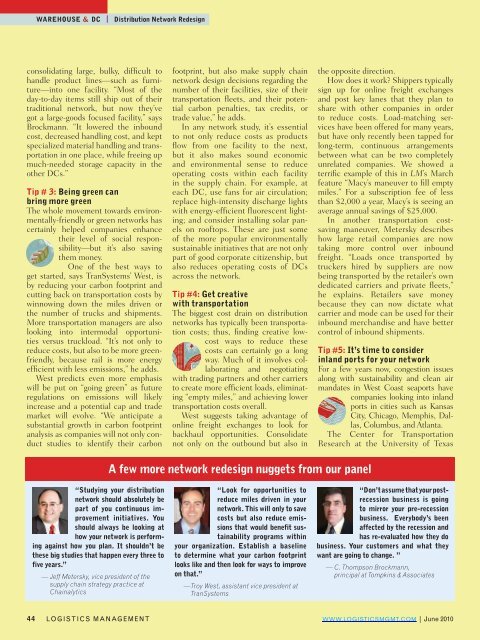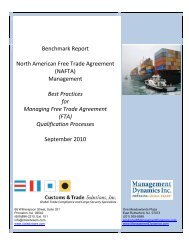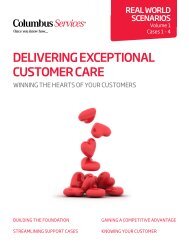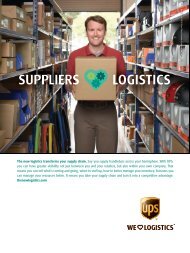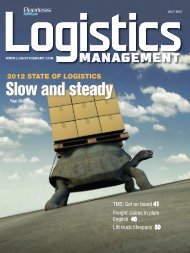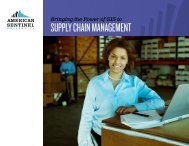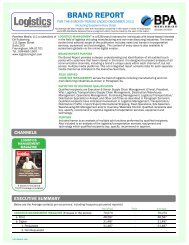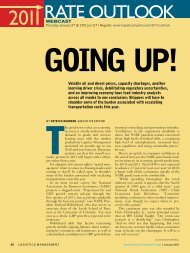Logistics Management - June 2010
Logistics Management - June 2010
Logistics Management - June 2010
You also want an ePaper? Increase the reach of your titles
YUMPU automatically turns print PDFs into web optimized ePapers that Google loves.
warehouse & Dc<br />
Distribution Network Redesign<br />
consolidating large, bulky, difficult to<br />
handle product lines—such as furniture—into<br />
one facility. “Most of the<br />
day-to-day items still ship out of their<br />
traditional network, but now they’ve<br />
got a large-goods focused facility,” says<br />
Brockmann. “It lowered the inbound<br />
cost, decreased handling cost, and kept<br />
specialized material handling and transportation<br />
in one place, while freeing up<br />
much-needed storage capacity in the<br />
other DCs.”<br />
Tip # 3: Being green can<br />
bring more green<br />
The whole movement towards environmentally-friendly<br />
or green networks has<br />
certainly helped companies enhance<br />
their level of social responsibility—but<br />
it’s also saving<br />
them money.<br />
One of the best ways to<br />
get started, says TranSystems’ West, is<br />
by reducing your carbon footprint and<br />
cutting back on transportation costs by<br />
winnowing down the miles driven or<br />
the number of trucks and shipments.<br />
More transportation managers are also<br />
looking into intermodal opportunities<br />
versus truckload. “It’s not only to<br />
reduce costs, but also to be more greenfriendly,<br />
because rail is more energy<br />
efficient with less emissions,” he adds.<br />
West predicts even more emphasis<br />
will be put on “going green” as future<br />
regulations on emissions will likely<br />
increase and a potential cap and trade<br />
market will evolve. “We anticipate a<br />
substantial growth in carbon footprint<br />
analysis as companies will not only conduct<br />
studies to identify their carbon<br />
footprint, but also make supply chain<br />
network design decisions regarding the<br />
number of their facilities, size of their<br />
transportation fleets, and their potential<br />
carbon penalties, tax credits, or<br />
trade value,” he adds.<br />
In any network study, it’s essential<br />
to not only reduce costs as products<br />
flow from one facility to the next,<br />
but it also makes sound economic<br />
and environmental sense to reduce<br />
operating costs within each facility<br />
in the supply chain. For example, at<br />
each DC, use fans for air circulation;<br />
replace high-intensity discharge lights<br />
with energy-efficient fluorescent lighting;<br />
and consider installing solar panels<br />
on rooftops. These are just some<br />
of the more popular environmentally<br />
sustainable initiatives that are not only<br />
part of good corporate citizenship, but<br />
also reduces operating costs of DCs<br />
across the network.<br />
Tip #4: Get creative<br />
with transportation<br />
The biggest cost drain on distribution<br />
networks has typically been transportation<br />
costs; thus, finding creative lowcost<br />
ways to reduce these<br />
costs can certainly go a long<br />
way. Much of it involves collaborating<br />
and negotiating<br />
with trading partners and other carriers<br />
to create more efficient loads, eliminating<br />
“empty miles,” and achieving lower<br />
transportation costs overall.<br />
West suggests taking advantage of<br />
online freight exchanges to look for<br />
backhaul opportunities. Consolidate<br />
not only on the outbound but also in<br />
the opposite direction.<br />
How does it work Shippers typically<br />
sign up for online freight exchanges<br />
and post key lanes that they plan to<br />
share with other companies in order<br />
to reduce costs. Load-matching services<br />
have been offered for many years,<br />
but have only recently been tapped for<br />
long-term, continuous arrangements<br />
between what can be two completely<br />
unrelated companies. We showed a<br />
terrific example of this in LM’s March<br />
feature “Macy’s maneuver to fill empty<br />
miles.” For a subscription fee of less<br />
than $2,000 a year, Macy’s is seeing an<br />
average annual savings of $25,000.<br />
In another transportation costsaving<br />
maneuver, Metersky describes<br />
how large retail companies are now<br />
taking more control over inbound<br />
freight. “Loads once transported by<br />
truckers hired by suppliers are now<br />
being transported by the retailer’s own<br />
dedicated carriers and private fleets,”<br />
he explains. Retailers save money<br />
because they can now dictate what<br />
carrier and mode can be used for their<br />
inbound merchandise and have better<br />
control of inbound shipments.<br />
Tip #5: It’s time to consider<br />
inland ports for your network<br />
For a few years now, congestion issues<br />
along with sustainability and clean air<br />
mandates in West Coast seaports have<br />
companies looking into inland<br />
ports in cities such as Kansas<br />
City, Chicago, Memphis, Dallas,<br />
Columbus, and Atlanta.<br />
The Center for Transportation<br />
Research at the University of Texas<br />
A few more network redesign nuggets from our panel<br />
“Studying your distribution<br />
network should absolutely be<br />
part of you continuous improvement<br />
initiatives. You<br />
should always be looking at<br />
how your network is performing<br />
against how you plan. It shouldn’t be<br />
these big studies that happen every three to<br />
five years.”<br />
— Jeff Metersky, vice president of the<br />
supply chain strategy practice at<br />
Chainalytics<br />
“Look for opportunities to<br />
reduce miles driven in your<br />
network. This will only to save<br />
costs but also reduce emissions<br />
that would benefit sustainability<br />
programs within<br />
your organization. Establish a baseline<br />
to determine what your carbon footprint<br />
looks like and then look for ways to improve<br />
on that.”<br />
—Troy West, assistant vice president at<br />
TranSystems<br />
“Don’t assume that your postrecession<br />
business is going<br />
to mirror your pre-recession<br />
business. Everybody’s been<br />
affected by the recession and<br />
has re-evaluated how they do<br />
business. Your customers and what they<br />
want are going to change. ”<br />
— C. Thompson Brockmann,<br />
principal at Tompkins & Associates<br />
44 <strong>Logistics</strong> <strong>Management</strong> WWW.LOGISTICSMGMT.COM | <strong>June</strong> <strong>2010</strong>


